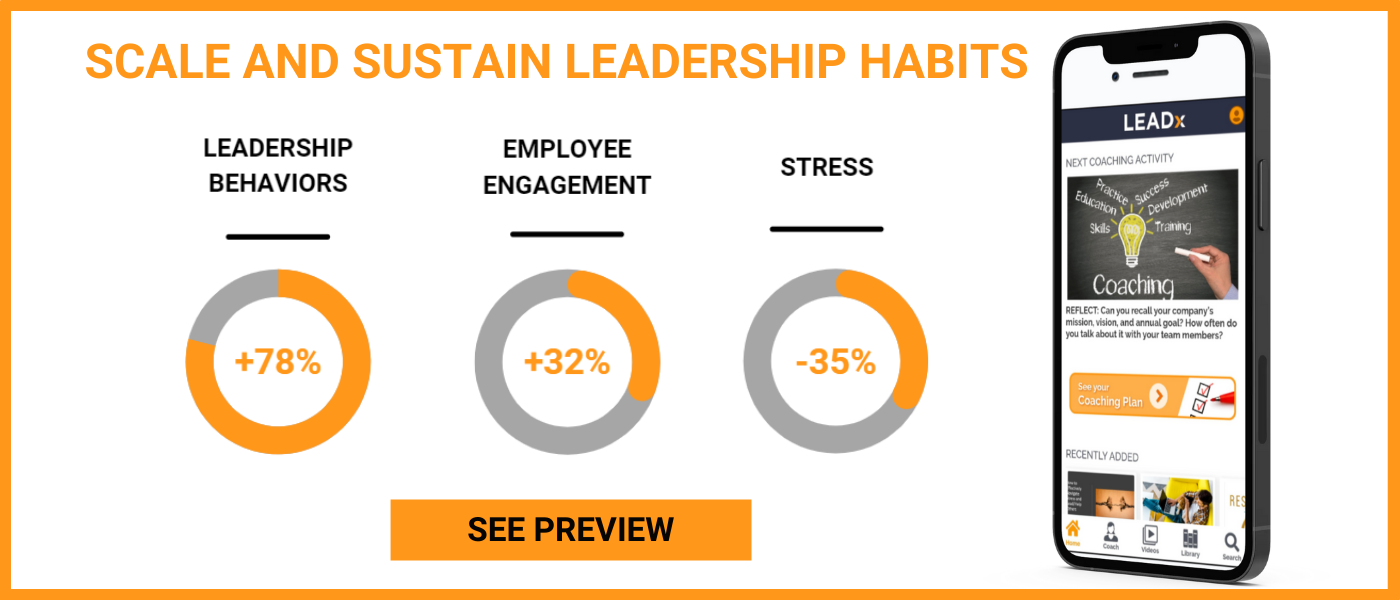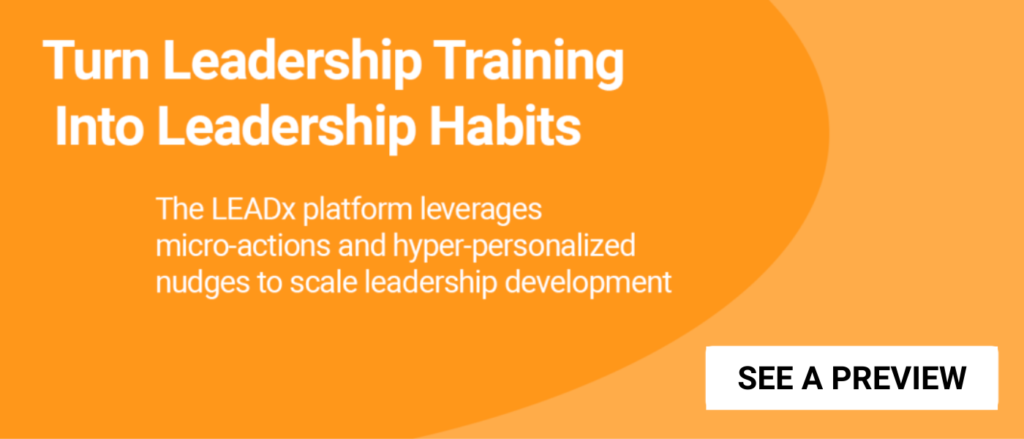
Imagine you’re shopping for a printer at a big, warehouse-style store. Upon arriving at the electronics aisle, you discover that the shelf advertising the model you’re looking for is empty. You find a nearby employee to inquire. She greets you warmly, and rather than leaving you waiting while she checks the back stockroom, she pulls up an inventory report on her phone. You learn the printer is out of stock at her store, but she can arrange to have one shipped to you. She gathers your information and makes the transaction right then and there. As you walk away satisfied, she smiles to herself, thankful her manager nudged her to watch a 2-minute video about effective customer conversations only hours earlier.
This kind of “on-the-floor” learning is the future of leadership development.
 Moving Learning out of the Classroom and into the Flow of Work
Moving Learning out of the Classroom and into the Flow of Work
Most of us know what it’s like to attend a classroom training session. You get pulled away from work for hours, and you try to make the most of your time. But, inevitably, the next day and the next week, you struggle to plug what you’ve learned into your day-to-day work. It’s likely no surprise that, within just 24 hours of attending a training session, attendees will forget 70 percent of the information presented.
But there’s a better way.
Leadership development pros are realizing that when learning doesn’t happen “in the flow of work,” learning simply doesn’t happen.
“Learning can’t be something that’s carved off to the side,” Sam’s Club SVP and chief people officer Chris Shryock recently told me. “When I toured clubs, I felt like people development wasn’t happening where daily work was happening. We've got to be right there, where associates are doing every other aspect of their job. If your learning program is not integrated with business processes, you're never going to be able to sustain it.”
Shryock, who oversees training and development for 100,000 associates across 600 Sam’s Club locations, has devoted a significant amount of attention to moving learning out of the classroom and onto the devices employees already use at work.
“I believe that our associates’ work should be ‘open book tests,’” said Shryock. “We want our associates to have the information they need at the moment they need it.”
Five Essentials for Learning On the Floor
To put your learning in the flow of work, you need a few tools in your toolkit. Here are five essential tools.
Tool #1: Micro-Learning. The best way for people to learn on the floor is with small, easy-to-digest pieces of content. Micro-learning closes the knowing-doing gap because, as Shryock discovered, when people can access information the moment they need it, they can apply it in real time.
For example, if a new manager has too much on her plate, she can pull up a short article with tips on how to delegate—right before meeting with her team. As such, on-the-floor micro-learning doesn’t interrupt the workday like a longer classroom training. It’s delivered as the work is happening—in short, non-disruptive bursts. An Association for Talent Development survey found that content that takes between two and five minutes to consume is most effective for micro-learning. As attention spans shrink and work responsibilities grow, managers will benefit from quick opportunities to learn on demand.
Tool #2: Personalized Nudges. Managers are busy. With workdays full of meetings and to-do’s to tackle, “nudges” to learn go a long way. Professors and authors Richard Thaler and Cass Sunstein define a nudge as “an indirect suggestion or subtle reminder intended to influence your behavior.” We experience nudges in daily life so often we don’t even notice them. Calendar notifications, appointment reminders, and even traffic lights are all examples of nudges intended to influence our behavior in one way or another. Applied to leadership development, nudges are little reminders to consume or apply learning content.
What’s more, personalizing nudges based on a leader’s strengths or growth areas can be even more impactful. Leadership development is about creating habits, after all. And you can’t form habits without a “cue” to perform a behavior. Nudges break through the noise of the modern workday to help leaders build learning habits into their schedules.
Tool #3: On-Demand, “Office-Hour” Style Coaching. Sometimes questions just can’t wait. Those who have worked with a coach in the traditional sense know that the most valuable conversations are those that happen spur-of-the-moment. As learning and development pros give managers options for learning in the flow of work, it’s important to also give people access to “coaching in the flow of work” as well. On-demand coaching offerings are becoming more widely available as the industry recognizes the need for more text-based communication options. The ability to text or live chat with an elite coach can deepen learning and provide a way for participants to move past challenges and speedbumps as they attempt to apply what they learned.
Tool #4: Peer Learning Networks. Peer learning is crucial for any leadership development program—on the floor included. Managers are more likely to retain and apply new information when given the opportunity to talk about it with peers. Creating a learning environment for peers can also facilitate real-world problem-solving. Catholic Health’s chief learning officer and vice president of organizational development, Tom Bigda-Peyton, leverages this approach. Cohorts of 8-10 managers and a facilitator regularly meet to discuss and workshop actual problems managers are facing.
“Ideally, the person [with the problem] starts to listen to their colleagues, and without necessarily reaching a solution, they will think about their problem differently—they will take away a new angle, an interesting idea, or a question to work from,” said Bigda-Peyton. “People will start to realize how the problems they’re facing are similar. So whether the learning was about decision-making, problem-solving, or collaboration, people begin to see how the learnings can be applied.”
Tool #5: Manager Sponsorship. In talking with leadership development professionals about increasing learner engagement, engaging managers is the number one strategy they cite as being most effective. For an “on-the-floor” learning program to succeed, participants must have support and accountability from their managers, who are on the floor with them. When a manager asks her direct report about training, carves time out of her employees’ schedules for learning, and models the skills the employee is learning, engagement skyrockets.
Close the Knowing-Doing Gap and Increase Engagement
While the future of learning is on the floor and in the flow of work, the future is already here for many leading organizations. To close the knowing-doing gap and increase learner engagement, take learning out of the classroom and put it in the flow of work.






